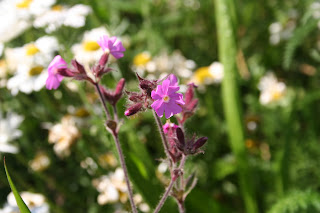I was chatting with a lovely lady this morning, a keen gardener with a lot of common sense. She installed some Meadowmat last autumn in some poor-ish soil that tends to be dry. The wild flower mat established well and has looked incredibly healthy, but after its first season, there is more grass in it than she’d like and fewer flowers.
 |
| pink campion appeared in my Meadowmat for the 1st time this year |
The Meadowmat in my own garden has just finished its second season of flowering and I have to be honest, it’s not the same as last year. I have less grass, more flowers and indeed, more species visible than there were in that first summer.
The theory is that after a year of careful management, there are now fewer plant nutrients in the soil beneath my Meadowmat and so the grasses are less vigorous giving the flowering plants a better chance of survival. I also think that Yellow Rattle has played a big part in the process, so I’ll be sowing some more of that this autumn.
 |
| yellow rattle - the meadow makers' superhero |
I’ve been told that it takes seven years to establish a species rich meadow from seed. Some of our native species are slow to germinate and won’t appear for two or three years; some need cold winters to help wake the seeds up, some need warm summers, some of the plants need to grow on for a while before they bloom. As Meadowmat is grown from seed on our farm in Norfolk, I can only suppose that I’m not going to see all of the flowering species in the first season and that it’s just going to get better and better.
So, for all of you first-year meadow growers out there, take comfort. Provided you follow a sensible management regime (hay cut in the summer then mowing through the autumn and winter removing ALL of the clippings every time) you can expect your wild flower patch to get better and better as the years go by. Mine has.
No comments:
Post a Comment